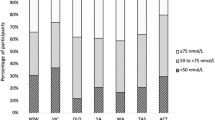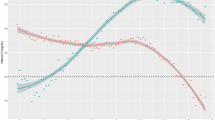Abstract
Background/Objectives:
Vitamin D levels are often observed to be low in Canadian youth, despite the mandatory fortification of fluid milk. We identified modifiable correlates of plasma vitamin D concentrations to inform public health efforts to remediate low-vitamin D status.
Subjects/Methods:
We recruited 159 children aged 8–11 years, who were at at high risk of obesity, non-systematically during different seasons. Vitamin D status was assessed by measuring plasma 25-hydroxyvitamin D (25(OH)D) using a radioimmunoassay. Dietary intake, including vitamin supplements, was measured using three dietitian-administered 24 h diet recalls. Fat mass was measured by dual energy X-ray absorptiometry. Accelerometers were worn for 7 days to estimate physical activity. Independent correlates of plasma 25(OH)D concentrations were identified using multiple regression in an analysis controlling for season of measurement.
Results:
Approximately, 7% of youth had hypovitaminosis D (25(OH)D ⩽37.5 nmol/l) during winter and spring when vitamin D levels are at their nadir. Only 55% of participants had vitamin D levels, which the Institute of Medicine considers optimal (25(OH)D >50 nmol/l). The mean dietary vitamin D intake, 6.6 mcg, was well below current recommendations set at 15 mcg. A serving increase in milk consumption and a s.d. increase in physical activity were associated with only a 2.9 and 2.1 nmol/l increase in plasma 25(OH)D, respectively. There was no association between 25(OH)D and adiposity.
Conclusions:
Our results indicate the challenges of obtaining adequate vitamin D intake from the current food supply to support a level of 25(OD)D >50 nmol/l.
This is a preview of subscription content, access via your institution
Access options
Subscribe to this journal
Receive 12 print issues and online access
$259.00 per year
only $21.58 per issue
Buy this article
- Purchase on Springer Link
- Instant access to full article PDF
Prices may be subject to local taxes which are calculated during checkout
Similar content being viewed by others
References
Bischoff-Ferrari HA, Giovannucci E, Willett WC, Dietrich T, Dawson-Hughes B (2006). Estimation of optimal serum concentrations of 25-hydroxyvitamin D for multiple health outcomes. Am J Clin Nutr 84, 18–28.
Calvo MS, Whiting SJ, Barton CN (2004). Vitamin D fortification in the United States and Canada: current status and data needs. Am J Clin Nutr 80, 1710S–1716S.
CDC (2000). CDC Growth Charts: United States. Accessed, December 2010.
Chiu KC, Chu A, Go VL, Saad MF (2004). Hypovitaminosis D is associated with insulin resistance and beta cell dysfunction. Am J Clin Nutr 79, 820–825.
Cleland V, Crawford D, Baur LA, Hume C, Timperio A, Salmon J (2008). A prospective examination of children's time spent outdoors, objectively measured physical activity and overweight. Int J Obes (Lond) 32, 1685–1693.
Dawson-Hughes B, Heaney RP, Holick MF, Lips P, Meunier PJ, Vieth R (2005). Estimates of optimal vitamin D status. Osteoporos Int 16, 713–716.
de Walle HE, de Jong-van den Berg LT (2008). Ten years after the Dutch public health campaign on folic acid: the continuing challenge. Eur J Clin Pharmacol 64, 539–543.
Dong Y, Pollock N, Stallmann-Jorgensen IS, Gutin B, Lan L, Chen TC et al. (2010). Low 25-hydroxyvitamin D levels in adolescents: race, season, adiposity, physical activity, and fitness. Pediatrics 125, 1104–1111.
Ekelund U, Aman J, Yngve A, Renman C, Westerterp K, Sjostrom M (2002). Am J Clin Nutr 76, 935–941.
Fox TA, Heimendinger J, Block G (1992). Telephone surveys as a method for obtaining dietary information: a review. J Am Diet Assoc 92, 729–732.
Garland CF, Garland FC, Gorham ED, Lipkin M, Newmark H, Mohr SB et al. (2006). The role of vitamin D in cancer prevention. Am J Public Health 96, 252–261.
Giovannucci E, Liu Y, Rimm EB, Hollis BW, Fuchs CS, Stampfer MJ et al. (2006). Prospective study of predictors of vitamin D status and cancer incidence and mortality in men. J Natl Cancer Inst 98, 451–459.
Gorham ED, Garland CF, Garland FC, Grant WB, Mohr SB, Lipkin M et al. (2007). Optimal vitamin D status for colorectal cancer prevention: a quantitative meta-analysis. Am J Prev Med 32, 210–216.
Health Canada. Eating Well with Canada's Food Guide. Health Canada, 2007
Heaney RP, Abrams S, Dawson-Hughes B, Looker A, Marcus R, Matkovic V et al. (2000). Peak bone mass. Osteoporos Int 11, 985–1009.
Holick MF (2003). Vitamin D: a millenium perspective. J Cell Biochem 88, 296–307.
Immunodiagnostic Systems Ltd. Gamma-B 25-Hydroxy Vitamin D radio-immunoassay. Immunodiagnostic Systems Ltd: Scottsdale, AZ, 2005.
Institute of Medicine. Dietary Reference Intakes for Calcium, Phosphorus, Magnesium, Vitamin D and Fluoride. National Academy Press: Washington (DC), 1997, pp 250–287.
Institute of Medicine. Dietary Reference Intake for Calcium and Vitamin D. National Academy Press: Washington (DC), 2010.
Langlois KG, Greene-Finestone L, Little J, Hidiroglou N, Whiting S (2010). Vitamin D status of Canadians as measured in the 2007–2009 Canadian Health Measures Survey. Health Rep 21, 46–55.
Lehtonen-Veromaa M, Mottonen T, Nuotio I, Irjala K, Viikari J (2002). The effect of conventional vitamin D2 supplementation on serum 25(OH)D concentration is weak among peripubertal Finnish girls: a 3-y prospective study. Eur J Clin Nutr 56, 431–437.
Loud KJ, Gordon CM (2006). Adolescent bone health. Arch Pediatr Adolesc Med 160, 1026–1032.
Mark S, Gray-Donald K, Delvin EE, O’Loughlin J, Paradis G, Levy E et al. (2008). Low vitamin D status in a representative sample of youth from Quebec, Canada. Clin Chem 54, 1283–1289.
Ness AR, Leary SD, Mattocks C, Blair SN, Reilly JJ, Wells J et al. (2007). Objectively measured physical activity and fat mass in a large cohort of children. PLoS Med 4, e97.
Parikh SJ, Edelman M, Uwaifo GI, Freedman RJ, Semega-Janneh M, Reynolds J et al. (2004). The relationship between obesity and serum 1,25-dihydroxy vitamin D concentrations in healthy adults. J Clin Endocrinol Metab 89, 1196–1199.
Pate RR, Stevens J, Pratt C, Sallis JF, Schmitz KH, Webber LS et al. (2006). Objectively measured physical activity in sixth-grade girls. Arch Pediatr Adolesc Med 160, 1262–1268.
Patrick K, Norman GJ, Calfas KJ, Sallis JF, Zabinski MF, Rupp J et al. (2004). Diet, physical activity, and sedentary behaviors as risk factors for overweight in adolescence. Arch Pediatr Adolesc Med 158, 385–390.
Roth DE, Martz P, Yeo R, Prosser C, Bell M, Jones AB (2005). Are national vitamin D guidelines sufficient to maintain adequate blood levels in children? Can J Public Health 96, 443–449.
Sallis JF, Prochaska JJ, Taylor WC (2000). A review of correlates of physical activity of children and adolescents. Med Sci Sports Exerc 32, 963–975.
Scragg R, Holdaway I, Jackson R, Lim T (1992). Plasma 25-hydroxyvitamin D3 and its relation to physical activity and other heart disease risk factors in the general population. Ann Epidemiol 2, 697–703.
Scragg R, Holdaway I, Singh V, Metcalf P, Baker J, Dryson E (1995). Serum 25-hydroxyvitamin D3 is related to physical activity and ethnicity but not obesity in a multicultural workforce. Aust N Z J Med 25, 218–223.
Scragg R, Camargo Jr CA (2008). Frequency of leisure-time physical activity and serum 25-hydroxyvitamin D levels in the US population: results from the third national health and nutrition examination survey. Am J Epidemiol 168, 577–586.
Trost SG, Pate RR, Sallis JF, Freedson PS, Taylor WC, Dowda M et al. (2002). Age and gender differences in objectively measured physical activity in youth. Med Sci Sports Exerc 34, 350–355.
Vieth R, Bischoff-Ferrari H, Boucher BJ, Dawson-Hughes B, Garland CF, Heaney RP et al. (2007). The urgent need to recommend an intake of vitamin D that is effective. Am J Clin Nutr 85, 649–650.
Vincent SD, Pangrazi RP, Raustorp A, Tomson LM, Cuddihy TF (2003). Activity levels and body mass index of children in the United States, Sweden, and Australia. Med Sci Sports Exerc 35, 1367–1373.
Wagner CL, Greer FR, and the Section on Breastfeeding and Committee on Nutrition (2008). Prevention of rickets and Vitamin D deficiency in infants, children, and adolescents. Pediatrics 122, 1142–1152.
Webb AR, Kline L, Holick MF (1988). Influence of season and latitude on the cutaneous synthesis of vitamin D3: exposure to winter sunlight in Boston and Edmonton will not promote vitamin D3 synthesis in human skin. J Clin Endocrinol Metab 67, 373–378.
Wells JC, Cole TJ (2002). Adjustment of fat-free mass and fat mass for height in children aged 8 y. Int J Obes Relat Metab Disord 26, 947–952.
Weng FL, Shults J, Leonard MB, Stallings VA, Zemel BS (2007). Risk factors for low serum 25-hydroxyvitamin D concentrations in otherwise healthy children and adolescents. Am J Clin Nutr 86, 150–158.
Acknowledgements
This study was supported by the Fonds de la Recherche en Santé du Québec (FRSQ), the Canadian Institutes of Health Research (CIHR) and an unrestricted grant from The Centrum Foundation. JO’L, holds a Canada Research Chair in the Childhood Determinants of Adult Chronic Disease. We gratefully acknowledge the assistance of James Hanley and Catherine Sabiston for his helpful insights into the statistical procedures and the accelerometer data, respectively.
Author information
Authors and Affiliations
Corresponding author
Ethics declarations
Competing interests
The authors declare no conflict of interest.
Additional information
Contributors: SM designed the research, analyzed data and wrote the paper. ML conducted and designed the research, oversaw the laboratory analysis of vitamin D and wrote the paper. ED oversaw the laboratory analysis of vitamin D and wrote the paper. JO’L and AT conducted the research and wrote the paper. KGD wrote the paper, designed the research and was responsible for the final content. All of the authors reviewed the manuscript critically for intellectual content and approved the final version to be published.
Rights and permissions
About this article
Cite this article
Mark, S., Lambert, M., Delvin, E. et al. Higher vitamin D intake is needed to achieve serum 25(OH)D levels greater than 50 nmol/l in Québec youth at high risk of obesity. Eur J Clin Nutr 65, 486–492 (2011). https://doi.org/10.1038/ejcn.2011.5
Received:
Revised:
Accepted:
Published:
Issue Date:
DOI: https://doi.org/10.1038/ejcn.2011.5
Keywords
This article is cited by
-
Vitamin D status in healthy Italian school-age children: a single-center cross-sectional study
Italian Journal of Pediatrics (2023)
-
Decreased vitamin D levels in the pediatric population after COVID-19 lockdown
Italian Journal of Pediatrics (2023)
-
Dietary vitamin D intake and colorectal cancer risk: a longitudinal approach within the PREDIMED study
European Journal of Nutrition (2021)
-
“Vitamin D supplementation and bone health in adults with diabetic nephropathy: the protocol for a randomized controlled trial”
BMC Endocrine Disorders (2014)
-
Vitamin D and K status influences bone mineral density and bone accrual in children and adolescents with celiac disease
European Journal of Clinical Nutrition (2012)



